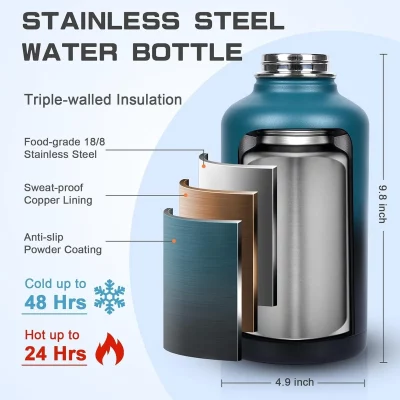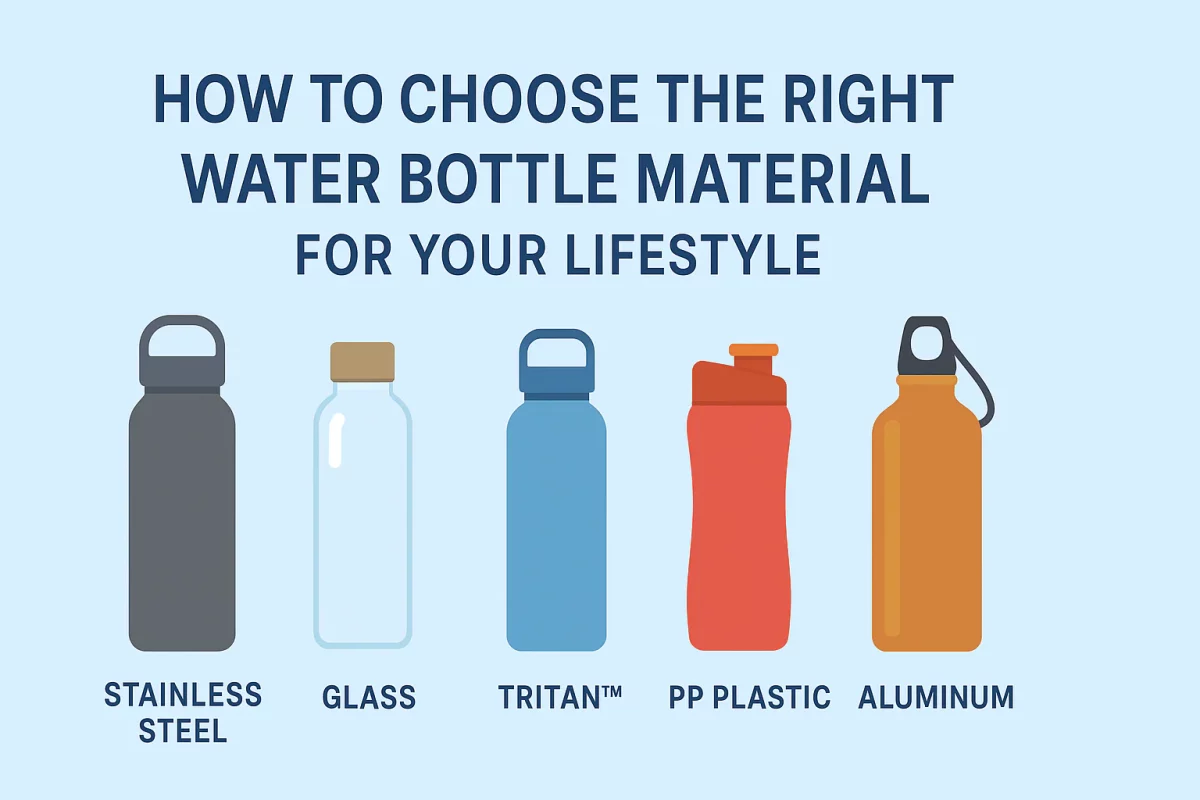Materials & Technology
A Guide to Sustainable Water Bottle Materials
Where Safety Meets Customization. As your trusted OEM/ODM partner, we produce a wide range of drink bottles and food containers. We ensure every product is crafted from food-contact safe materials and is certified BPA-free, fully adhering to FDA, LFGB, and California Proposition 65 requirements.

Main Material List of Water Bottle
/Cup /Flask /Jug /Food Container /Beverage Vessel
| Main Material
Type |
Advantages | Disadvantages | FDA Compliant | BPA Free | Insulated | Applications for
Drink Bottle |
Material Cost | |
| Aluminum | AI | Lightweight, durable, good corrosion resistance. | Can dent, may impart metallic taste. Requires interior liner. Liner can degrade. | Yes (with compliant liner) | Yes (liner dependent) | Only when double-walled | Lightweight sport bottles, canteens, reusable everyday bottles. | Low to Medium |
| Stainless Steel | SS201 (Stainless Steel 18-1, Japan JIS: SUS201, USA AISI: 201) |
Strong, magnetic, cost-effective stainless option. | Lower corrosion resistance than 304/316. Can rust over time. | Yes | Yes | Only when double-walled | Budget-friendly insulated bottles, promotional items. | Low |
| SS304 (Stainless Steel 18-8, Japan JIS: SUS304, USA AISI: 304) |
Excellent corrosion resistance, durable, does not rust easily. Industry standard. | Heavier than plastic/aluminum. Can transfer temperature (hot/cold to touch). | Yes | Yes | Only when double-walled | High-quality insulated tumblers, food-grade bottles, everyday & sports use. | Medium | |
| SS316 (Stainless Steel 18-10, Japan JIS: SUS316, USA AISI: 316) |
Superior corrosion & chloride resistance (e.g., saltwater), very durable. | Heavier and more expensive than 304. | Yes | Yes | Only when double-walled | Premium insulated bottles, marine/chemical industry use, high-end consumer goods. | High | |
| Titanium | Ti-6Al-4VEli | Extremely strong yet very lightweight. Highly corrosion-resistant. Biocompatible. | Very expensive. Can feel “premium” but is often overkill for casual use. | Yes | Yes | Only when double-walled (rare) | Ultralight backpacking, mountaineering, premium specialty bottles. | Very High |
| Plastic | PP
(Polypropylene) |
Lightweight, durable, excellent chemical resistance. Withstands dishwashers. | Can become brittle in extreme cold. Not as crystal-clear as other plastics. | Yes | Yes | No | Squeezable sports bottles, baby bottles, dishwasher-safe containers. | Low |
| AS
(Acrylonitrile-Styrene) |
Hard, rigid, and crystal-clear transparency. Good gloss. | Lower chemical resistance than others. Can be brittle and crack under impact. | Yes | Yes | No | Transparent bottle bodies (where clarity is needed), decorative layers. | Low | |
| PC
(Polycarbonate) |
Very high impact strength, crystal-clear, and heat resistant. | Not BPA-Free. BPA is a precursor in its production. Prone to scratching. | No (for food contact, largely phased out) | No | No | Largely discontinued for bottles. Was used for reusable jugs, baby bottles. | Low | |
| Tritan (PCTG) | High impact strength, BPA-free, crystal-clear, odor & stain resistant. | Can be less heat resistant than PC. Higher cost than PP or PC. | Yes | Yes | No | Premium BPA-free sports bottles, kids’ bottles, replacement for PC. | Medium | |
| ABS | Very strong, rigid, and impact-resistant. Good heat resistance. | Not typically used for liquid contact; often opaque. Can be scratched. | Yes (specific grades) | Yes | No | Bottle caps, hard-wearing external shells, protective cases. | Low | |
| Acrylic (PMMA) | Excellent optical clarity and gloss, UV resistant. | Very brittle and low impact strength. Scratches easily. | Yes (specific grades) | Yes | No | Decorative components, windows in sports caps, not for primary bodies. | Low | |
| POM (Acetal) | High strength, stiffness, and excellent wear/slip properties. “Self-lubricating”. | Not suitable for prolonged liquid contact. Used for mechanical parts. | Yes (limited contact) | Yes | No | Screw caps, sprayer mechanisms, hinged components. | Medium | |
| TPE/TPR (Elastomers) | Flexible, soft-touch, excellent grip and seal. | Porous surface can absorb odors/stains. Lower chemical resistance. | Yes (specific grades) | Yes | No | Squeeze bulbs, gaskets, seals, soft-grip sleeves, straws. | Low to Medium | |
| PPSU (Polyphenylsulfone) | Medical-grade, high heat & chemical resistance. Can be sterilized (autoclave). | Very high cost. Often has a slight amber/yellow tint. | Yes | Yes | No | Premium, medical-grade, and high-performance baby bottles. | Very High | |
| Recycled Ocean Plastic | Positive environmental story, reduces ocean waste. Durable (depends on source). | Consistency and color can vary. May have visible flecks or imperfections. | Yes (processed to compliance) | Typically Yes | No | Eco-conscious lifestyle bottles, promotional items by green brands. | Medium (processing cost) | |
| Silicone | Solid Silicone | Flexible, heat resistant, soft-touch, excellent seal. Chemically inert. | Can attract lint and dust. Can be pierced or torn with sharp objects. | Yes (food-grade) | Yes | No | Collapsible cups/funnels, gaskets, lids, entire collapsible bottles. | Medium |
| Liquid Silicone | Superior consistency, no seams, high precision for small parts. Softer feel. | Generally higher cost than solid silicone molding for large parts. | Yes (food-grade) | Yes | No | Straws, spouts, valve components, baby bottle nipples. | Medium to High | |
| Glass | Soda-Lime Glass | Inert, does not leach chemicals. Preserves taste perfectly. Inexpensive. | Heavy and fragile. Can shatter into sharp pieces. | Yes | Yes | No | Everyday kitchen drinking jars, milk bottles, juice bottles. | Low |
| Borosilicate Glass | Highly resistant to thermal shock (hot/cold). Stronger than soda-lime. | Still breakable, though less so than soda-lime. Heavier than plastic/metal. | Yes | Yes | No | Premium beverage bottles, laboratory glassware, heat-resistant containers. | Medium |
Auxiliary Material List
of Custom Vacuum Insulated Stainless Steel Drink Bottles/Hydro Jugs/Flasks/Cups/Tumblers
| Auxiliary Material Type | Application / Function | FDA Compliant | BPA Free |
| Copper | Used as a coating on the inner wall of the vacuum chamber in some high-performance insulated bottles. Its high thermal conductivity enhances heat exchange reflection, potentially improving insulation efficiency. | Yes (when plated/sealed and not in direct food contact) | Yes (Metallic element) |
| Aluminum Foil | Acts as a radiation barrier within the vacuum space of double-walled bottles. It reflects radiant heat, contributing to the overall thermal insulation performance. It is also used in laminated pouches as a getter indicator. | Yes (when used as a barrier and not in direct, prolonged food contact) | Yes (Metallic element) |
| Getter | A small, porous pellet or strip placed inside the vacuum space during manufacturing. Its function is to adsorb any residual gases or gases that slowly leak out over time (a process called “outgassing”), thereby maintaining a high vacuum for the lifespan of the bottle. | N/A (The getter is permanently sealed inside the vacuum chamber and has no direct contact with the beverage.) | Typically Yes (Common materials are iron oxide or zeolite-based, which are BPA-free.) |
Conclusion
Selecting a custom drink bottle goes beyond function—it’s about understanding your audience. A premium stainless steel bottle conveys quality to corporate clients, a safe Tritan bottle shows care for families, and an eco-friendly option aligns with green values. The right material makes your gift meaningful and strengthens your brand connection.
Want a branded bottle that truly resonates? ANhui IFun is ready to assist. Contact us for a tailored solution and free samples to ensure your custom bottle perfectly matches your vision and audience.

